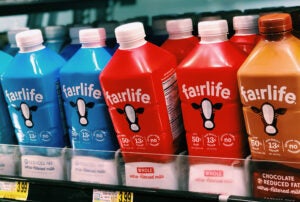Although dairy is generally recognized as a cornerstone of a healthy diet, many Americans continue to fall short of the recommended daily intake as endorsed by the Dietary Guidelines for Americans, issued by the federal departments of Agriculture and Health and Human Services. every five years. An in-depth consumer survey released by the International Food Information Council examines barriers to dairy consumption among Americans, as well as offers solutions on how to remove them.
It found that 78 percent of Americans believe that dairy is necessary, but many are not taking advantage of its benefits. Generally, this is because there is a disconnect between the perception of these consumers and actual dairy intake.
The report, entitled Understanding Fluid Milk & Dairy Food Consumption Patterns to Improve Diet Quality and Nutritional Equity, provides a roadmap for how industry, government, and health and nutrition groups can improve awareness of and access to lactose-free milk and dairy products; broaden understanding of the nutritional value of dairy; and working with the dairy industry to extend shelf life and improve the value of dairy purchases for consumers.
Providing more information about what drives or hinders dairy consumption can help stakeholders’ efforts to improve consumer education, identify effective outreach partners, increase knowledge of nutritional value and health benefits, and address potential barriers to consuming recommended amounts of dairy as part of it. healthy diet pattern.
Key data points of the report include:
- Missed Opportunities for Lactose-Free: Nearly two in three Americans say they have never consumed lactose-free milk (64 percent), flavored lactose-free milk (76 percent), or other lactose-free dairy products other than milk (68 percent). ). The rate of non-consumption is more than half among Latino, Black, and Asian/Pacific Islander communities, indicating low awareness among groups reporting higher rates of lactose sensitivity.
- Affordability a Key Factor for SNAP and Non-SNAP Households Similarly: About 30 percent of all races and ethnicities at all income levels cite affordability as a reason for drinking milk.
- Expiry Dates and “Passive Avoidance” Top Barriers: Concern about spoilage before use (19 percent), is one of the main reasons consumers avoid milk. Meanwhile, 37 percent of respondents cited no specific reason for limiting dairy consumption, suggesting “passive avoidance” that could be overcome with greater media, health care and community outreach. Self-reported lactose sensitivities also contribute to higher levels of avoidance.
- Best Taste and Health Purchase Drivers, Cheese Reigns Supreme: Cheese is the most frequently consumed dairy product (90 percent per week), followed by butter (85 percent), milk (75 percent), and yogurt ( 60 percent) thereafter. Taste is overwhelmingly the number one factor for consumers to buy cheese, yogurt and milk, followed by dairy as a good source of protein. Health benefits cited include bone health being the most recognized (90 percent), with other benefits including immune system support (65 percent) and heart health (54 percent).

The survey was sponsored by the International Dairy Foods Association and the National Milk Producers Federation, and includes Black, Latino, Asian/Pacific Islander and White Non-Hispanic consumers’ beliefs, behaviors and attitudes toward dairy.
The prevalence of lactose intolerance among BIPOC communities, concerns about expiration dates, and goals to reduce saturated fat intake create opportunities to increase awareness and accessibility of lactose-free, reduced, and non-fat, as well as innovative, safe dairy products . extending expiration dates, making the recommended amount of dairy consumed and ultimately, increasing the quality of the diet actionable and attainable for all Americans.
“Good nutrition is the foundation of health and wellness for adults and children across all demographics, and dairy is a critical part of a healthy diet starting at a young age,” said Michelle Matto, MPH, RDN , associate vice president of regulatory affairs. and nutrition, IDFA. “This survey shows that consumers value dairy for nutrition and taste but may lack sufficient information or access to the types of dairy that are right for them and their families. It shows that dairy must expand its partnerships with communities of color, health and nutrition experts, and policymakers to remove barriers that prevent Americans from getting adequate dairy nutrition, including quality protein , calcium, vitamin D, potassium, and health benefits. including better bone health and lower risk of type 2 diabetes and cardiovascular disease.”
The survey shows the clear need for greater education efforts, said Miquela Hanselman, NMPF director of regulatory affairs.
“IFIC’s research provides data behind the importance of dairy nutrition and the need for better education about the dairy options available and the benefits they provide,” said Hanselman. “When discussing the next Dietary Guidelines, it is important that this information is communicated clearly and strongly to everyone who could benefit from it, from consumers who need dairy nutrition to policy makers determined by federal programs.”
IFIC’s research highlights the importance of targeted outreach programs to improve the overall quality of nutrition and achieve greater nutritional equity.

